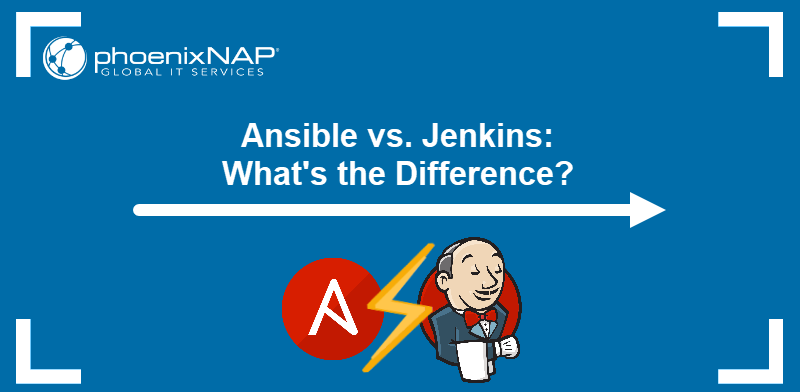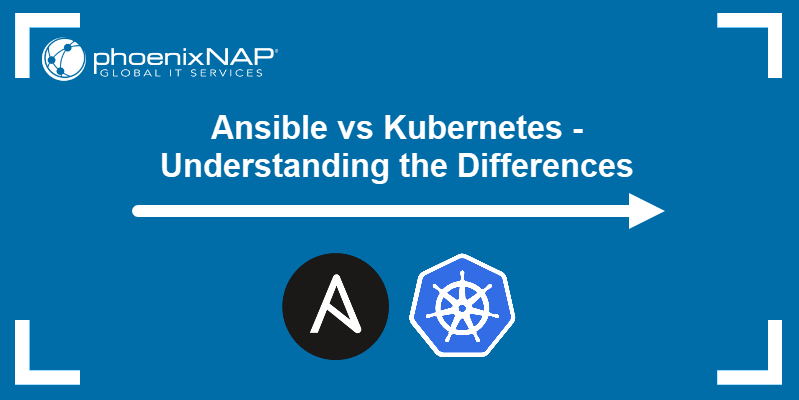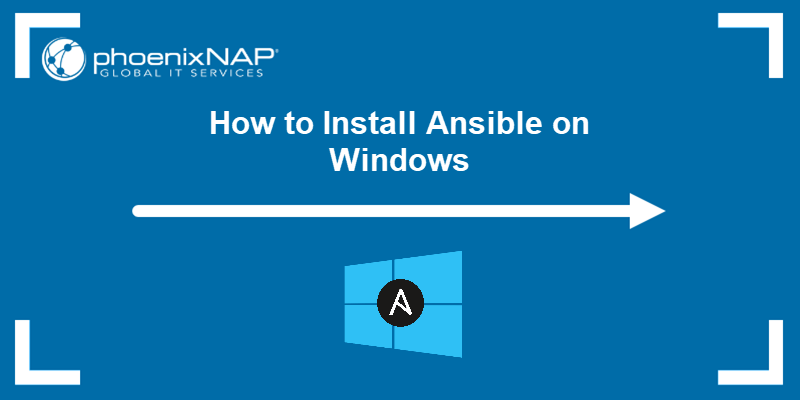Introduction
Infrastructure-as-Code (IaC) tools, such as SaltStack and Ansible, are essential in modern enterprise IT infrastructure management. These tools help tackle the fragmentation of multi-cloud and hybrid cloud deployments, which use diverse asset types like bare metal cloud or dedicated bare metal instances.
This article compares two well-known IaC platforms for infrastructure automation and configuration management, SaltStack and Ansible.
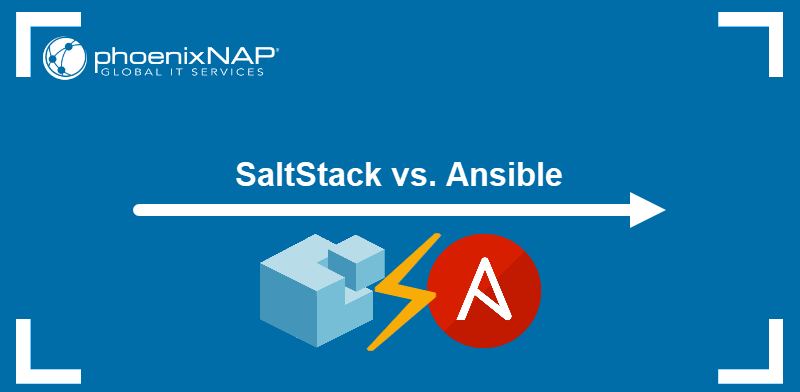
What Is SaltStack?
VMWare's SaltStack (also known as Salt) is an IT automation engine for infrastructure management that combines a declarative YAML approach with event-driven automation. The tool provides a fast, scalable solution for remote code execution and infrastructure configuration.
What Is Ansible?
Red Hat's Ansible is an IaC tool for configuring systems, provisioning infrastructure, and deploying applications. It uses YAML-based Playbooks to describe automation jobs and utilizes agentless architecture for fast and secure operation.
SaltStack vs. Ansible: Comparison
SaltStack and Ansible perform similar automation functions. However, their focus, design, and performance differ. The following sections provide a point-by-point comparison between the two platforms.
Features
SaltStack is an open-source tool written in Python. The main SaltStack feature is the ZeroMQ messaging library that allows the master (server) and minions (agents) to create persistent TCP connections. The tool is also highly scalable horizontally and vertically. Additionally, SaltStack enables redundancy by allowing for the configuration of multiple masters.
Ansible is also an open-source python-based platform. It features easy-to-learn procedures, streamlined architecture, and modular design. The platform offers many plugins and modules that customize and extend the tool's functionality. Another essential feature of Ansible is the dynamic inventory script, which uses provided parameters to generate inventories.
Note: The Ansible trusted content collection features modules that help integrate infrastructure providers into specific configurations. PhoenixNAP is a part of the Ansible trusted content collection with the Bare Metal Cloud Ansible module.
Architecture
SaltStack's architecture is based on the server/client model. The following list shows the platform's most important components:
- Salt Master is the master daemon instance that controls client instances by issuing commands and configuration requests. Configurations with more than one master instance always have a single Salt Master that manages the rest.
- Event Bus contains the event library, which listens to events from the clients and forwards the events to other parts of the Salt Master.
- Reactor is the Salt Master component that triggers actions based on the events received from the Event Bus.
- Salt Minions are the computers on which SaltStack's client application runs.
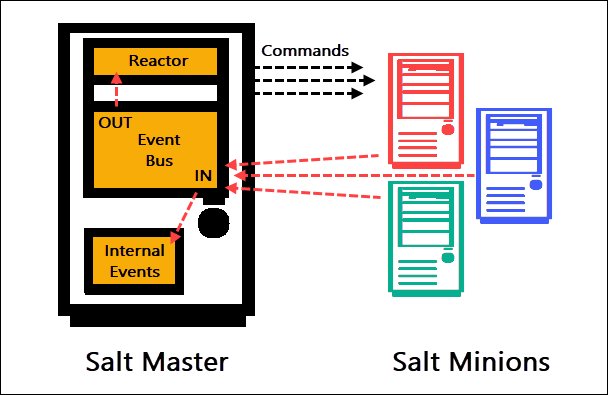
Ansible has agentless architecture. Ansible engine resides on a single server and accepts commands via Playbooks, special YAML-based files with instructions about the system's desired state. The engine then uses SSH to communicate with managed instances.
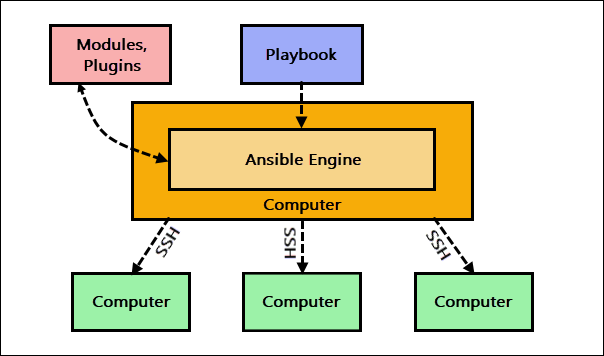
Note: SaltStack also has an agentless mode, which uses SSH to issue commands. However, this mode offers significantly slower performance than the default ZeroMQ mode.
API and Extensibility
SaltStack offers two API types as entry points for interfacing with other applications.
- Python Client API allows Python applications to communicate with various SaltStack components, such as
optsdictionary, loader interface, and client interfaces. - netapi modules enable access to externally-facing services (REST, XMPP, WebSockets, etc.). However, most of these features are only available for enterprise customers.
SaltStack is a highly extensible platform, allowing for the creation of modules that enable new execution models, states, etc.
Ansible Python API can extend Ansible with plugins and modules to control certain aspects of the system (e.g., node management). REST API is available for the users of Ansible Tower, the commercial Ansible solution.
Integrations
SaltStack supports major cloud providers, but Ansible offers much more integration. The main advantage of Ansible in this sense is its ability to integrate with many DevOps tools, such as Jenkins and Terraform, and containerization solutions, like Docker and Kubernetes.
Speed
SaltStack uses the event bus to exchange data between the master and the minions. This feature makes it faster than Ansible, which uses the standard, open internet connection. Aside from providing a significant speed boost, the message bus allows SaltStack to work in restricted environments.
Orchestration
SaltStack offers the ability to orchestrate administrative tasks across physical and cloud environments. The orchestration features are enforced with orchestration SaLt State (SLS) files.
Ansible's task-based design and simple syntax facilitate the orchestration of complex tasks. These features make Ansible a good choice for upgrading multi-node production infrastructure.
Pricing
Both SaltStack and Ansible have a free version and paid enterprise packages.
- SaltStack Enterprise offers different prices based on the number of managed nodes and the support level.
- Ansible Tower is Ansible's commercial offering. The pricing starts at 5000$ a year for the package that does not include support and 14000$ a year for full-time support.
Documentation and Support
VMWare provides paid support services, while free support for SaltStack is available on GitHub. Ansible has an extensive online community that assists users free of charge, and Red Hat is behind commercial support. Both platforms have online documentation, but Ansible's documentation is more comprehensive.
Note: Check out our list of other Ansible alternatives.
SaltStack vs. Ansible: Use Cases
The primary use case for both SaltStack and Ansible is to provide a way to define and provision infrastructure through code. The sections below give some of the use cases specific to each tool.
SaltStack
SaltStack is used in the following scenarios:
- Deploying IaC in HA environments.
- Detecting and fixing configuration drift.
- Building and deploying server instances on multiple platforms.
- IaC on Windows-centric configurations.
- Obtaining lists of installed software on each minion.
- Monitoring disk usage.
Ansible
Ansible use cases include:
- Provisioning Linux-based bare metal servers and VMs.
- Automating hybrid cloud and edge deployments.
- Managing physical, software-defined, and cloud networks.
- Automating security.
- Automating application deployments.
- Supporting CI/CD pipeline by ensuring continuous delivery.
SaltStack vs. Ansible: How To Choose?
Due to its ability to scale horizontally and vertically and the redundancy it can provide with multiple masters, SaltStack is a better choice for high-availability environments. Another advantage SaltStack has over Ansible is cloud deployments, where its speed and flexibility make an essential difference.
Choose Ansible if you need a solution for basic configuration management. Ansible is a good choice for beginners and non-coders since the learning curve is lower than SaltStack. Furthermore, simple app deployments benefit from Ansible's direct and unencumbered approach to infrastructure orchestration.
Note: Refer to our article on Ansible vs Terraform to learn how these two tools stack up against each other.
Conclusion
This article provided a comprehensive overview of the two popular infrastructure automation solutions, SaltStack and Ansible. After reading the comparison points, you should better understand how the two differ regarding features and performance.
Learn more about Infrastructure as Code by reading What is Infrastructure as Code - benefits, best practices, and tools.
